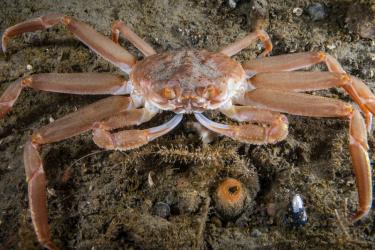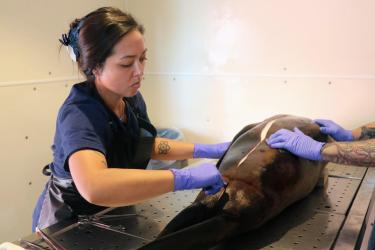The following stoplight table presents a number of climate and atmospheric, local physical, and local biological indicators used to characterize the ocean conditions that may affect the growth and survival of juvenile salmon in the northern California Current. The table compares data across all years sampled, and each indicator is ranked and color-coded based on whether they are “good”, “bad," or “neutral” for juvenile salmon growth and survival.
Stoplight Table
Stoplight Table with Rankings
This table shows the years ranked low to high (numbers) based on whether ocean conditions are favorable or unfavorable for juvenile salmon survival.
Raw Data
Download the raw data file (.csv) or view below.
| Ecosystem Indicators | 1998 | 1999 | 2000 | 2001 | 2002 | 2003 | 2004 | 2005 | 2006 | 2007 | 2008 | 2009 | 2010 | 2011 | 2012 | 2013 | 2014 | 2015 | 2016 | 2017 | 2018 | 2019 | 2020 | 2021 | 2022 | 2023 | 2024 |
|---|---|---|---|---|---|---|---|---|---|---|---|---|---|---|---|---|---|---|---|---|---|---|---|---|---|---|---|
| PDO (Sum Dec-March) | 5.07 | -1.75 | -4.17 | 1.86 | -1.73 | 7.45 | 1.85 | 2.44 | 1.94 | -0.17 | -3.06 | -5.41 | 2.17 | -3.65 | -5.07 | -1.67 | 1.24 | 9.26 | 6.69 | 3.38 | 1.52 | 2.01 | -0.76 | -2.77 | -5.32 | -5.63 | -3.07 |
| PDO (Sum May-Sept) | -0.8 | -6.79 | -3.64 | -4.58 | -0.94 | 2.54 | 1.18 | 1.93 | 0.64 | 1.63 | -5.89 | -0.19 | -4.05 | -6.95 | -7.58 | -4 | 2.89 | 5.96 | 3.31 | 1.66 | -0.51 | 2.11 | -3.33 | -6.52 | -9.12 | -9.22 | -11 |
| ONI (Average Jan-June) | 1.117 | -1.07 | -1.07 | -0.4 | 0.183 | 0.267 | 0.2 | 0.467 | -0.3 | 0.083 | -0.98 | -0.23 | 0.55 | -0.72 | -0.43 | -0.3 | -0.28 | 0.667 | 1.217 | 0.133 | -0.45 | 0.717 | 0.283 | -0.72 | -0.98 | 0.05 | 0.95 |
| SST NDBC buoys (°C; May-Sept) | 13.77 | 13.2 | 13.33 | 12.98 | 13.05 | 13.56 | 14.68 | 13.58 | 12.73 | 13.64 | 12.45 | 13.44 | 12.76 | 13.23 | 13.34 | 13.72 | 14.03 | 13.89 | 13.83 | 13.59 | 13.71 | 14.68 | 13.4 | 12.95 | 13.73 | 13.64 | 13.42 |
| Upper 20 m T (°C; Nov-Mar) | 12.3 | 10.31 | 10.12 | 10.22 | 10.08 | 10.73 | 10.86 | 10.59 | 10.61 | 10.04 | 9.327 | 10.19 | 11.01 | 10.02 | 9.621 | 10.12 | 9.615 | 12.73 | 12.03 | 11.47 | 10.63 | 10.99 | 9.372 | 10.12 | 10.55 | 9.864 | 11.56 |
| Upper 20 m T (°C; May-Sept) | 10.4 | 10.07 | 10.16 | 9.764 | 8.971 | 9.621 | 11.32 | 10.73 | 9.972 | 10.07 | 9.298 | 9.896 | 10.42 | 9.95 | 9.924 | 10.43 | 10.95 | 10.21 | 10.3 | 10.14 | 10.34 | 11.31 | 10.87 | 9.666 | 10.85 | 9.79 | 10.13 |
| Deep temperature (°C; May-Sept) | 8.614 | 7.628 | 7.742 | 7.558 | 7.462 | 7.809 | 7.881 | 7.969 | 7.833 | 7.575 | 7.476 | 7.734 | 7.651 | 7.809 | 7.557 | 7.937 | 8.38 | 8.138 | 7.881 | 8.056 | 8.106 | 8.044 | 8.676 | 7.5 | 8.156 | 8.142 | 7.746 |
| Deep salinity (May-Sept) | 33.54 | 33.86 | 33.78 | 33.86 | 33.85 | 33.68 | 33.66 | 33.77 | 33.85 | 33.88 | 33.87 | 33.72 | 33.72 | 33.75 | 33.75 | 33.76 | 33.53 | 33.71 | 33.83 | 33.85 | 33.85 | 33.79 | 33.54 | 33.9 | 33.62 | 33.71 | 33.64 |
| Copepod richness anom. (no. species; May-Sept) | 4.187 | -2.93 | -3.76 | -1.38 | -1.47 | 1.637 | 1.071 | 4.037 | 2.331 | -0.98 | -1.11 | -1 | 2.771 | -2.48 | -1.66 | -2.86 | -0.46 | 7.071 | 7.804 | 2.437 | 0.037 | -0.3 | -2.03 | -2.8 | -3.53 | -1.61 | -0.36 |
| N. copepod biomass anom. (mg C m-3; May-Sept) | -0.73 | 0.077 | 0.175 | 0.12 | 0.229 | -0.14 | 0.046 | -0.85 | -0.07 | 0.091 | 0.216 | 0.155 | 0.113 | 0.4 | 0.358 | 0.272 | 0.239 | -0.39 | -0.9 | -0.56 | 0.157 | 0.333 | 0.452 | 0.559 | 0.08 | 0.155 | 0.306 |
| S. copepod biomass anom. (mg C m-3; May-Sept) | 0.579 | -0.25 | -0.23 | -0.24 | -0.25 | 0.069 | 0.184 | 0.526 | 0.051 | -0.09 | -0.25 | -0.21 | 0.187 | -0.16 | -0.21 | -0.22 | -0.04 | 0.395 | 0.484 | 0.297 | -0.02 | 0.105 | -0.16 | -0.24 | -0.23 | -0.17 | -0.07 |
| Biological transition (day of year) | -- | 134 | 102 | 101 | 120 | 156 | 146 | 238 | 150 | 89 | 64 | 65 | 169 | 82 | 125 | 91 | 91 | -- | -- | 193 | 149 | 156 | 97 | 106 | 83 | 148 | 158 |
| Nearshore Ichthyoplankton Log(mg C 1,000 m-3; Jan-Mar) | 0.475 | 1.617 | 0.966 | 0.908 | 1.928 | 0.398 | 0.321 | 0.499 | 1.148 | 0.478 | 1.62 | 0.621 | 1.882 | 1.215 | 1.538 | 1.085 | 0.458 | 0.524 | 0.495 | 0.64 | 1.13 | 0.464 | 1.258 | 1.369 | 0.73 | 1.337 | 0.2 |
| Nearshore/offshore Ichthyoplankton community index (PCO axis 1 scores; Jan-Mar) | -11.7 | -24.8 | -30.5 | -21.8 | -17 | -6.99 | 15.64 | 32.21 | -37.3 | 5.931 | -32.7 | -5.88 | 11.09 | -28.4 | -33.9 | -17.8 | -17.5 | 28.74 | 32.58 | 36.01 | 26.03 | 31.26 | 11.45 | 2.334 | -0.2 | 10.98 | 42.25 |
| Chinook salmon juvenile catches Log (no. km-1; June) | 0.094 | 0.286 | 0.225 | 0.122 | 0.233 | 0.204 | 0.149 | 0.059 | 0.166 | 0.179 | 0.434 | 0.22 | 0.245 | 0.157 | 0.286 | 0.245 | 0.216 | 0.151 | 0.105 | 0.025 | 0.118 | 0.159 | 0.087 | 0.178 | 0.184 | 0.148 | 0.172 |
| Coho salmon juvenile catches Log (no. km-1; June) | 0.077 | 0.284 | 0.237 | 0.436 | 0.417 | 0.428 | 0.216 | 0.074 | 0.255 | 0.468 | 0.448 | 0.328 | 0.311 | 0.252 | 0.262 | 0.49 | 0.303 | 0.256 | 0.257 | 0.069 | 0.46 | 0.258 | 0.236 | 0.276 | 0.378 | 0.438 | 0.445 |
| Mean of Ranks | 23 | 7.813 | 9.375 | 9.813 | 7.813 | 17.13 | 20.63 | 21.5 | 13.88 | 12.13 | 3.938 | 11.06 | 15.19 | 9 | 7.438 | 10.25 | 16.06 | 22.56 | 22.38 | 20.63 | 15.13 | 19.38 | 14.94 | 7.125 | 12.31 | 11.69 | 15.44 |
| Rank of the mean ranks | 27 | 4 | 7 | 8 | 4 | 20 | 22 | 24 | 14 | 12 | 1 | 10 | 17 | 6 | 3 | 9 | 19 | 26 | 25 | 22 | 16 | 21 | 15 | 2 | 13 | 11 | 18 |
| Principal Component scores (PC1) | 5.488 | -2.84 | -2.41 | -1.82 | -2.71 | 1.115 | 2.384 | 4.077 | -0.28 | -0.71 | -4.76 | -1.47 | 0.097 | -2.41 | -3.05 | -1.97 | 0.385 | 5.328 | 5.47 | 3.342 | 0.168 | 2.248 | -0.08 | -2.86 | -1.5 | -1.52 | 0.293 |
| Principal Component scores (PC2) | 0.189 | -0.87 | 0.364 | -1.09 | -2.25 | -0.9 | 2.097 | -0.53 | -1.82 | -0.38 | -2.24 | 0.456 | -1.47 | 0.419 | -0.19 | 0.97 | 2.871 | -1.52 | -2.3 | -0.85 | 0.178 | 1.969 | 3.177 | -0.93 | 2.697 | 0.981 | 0.963 |
| Ecosystem Indicators not included in the mean of ranks or statistical analyses | |||||||||||||||||||||||||||
| Physical Spring Trans. UI based (day of year) | 83 | 88 | 134 | 120 | 84 | 109 | 113 | 142 | 109 | 70 | 87 | 82 | 95 | 105 | 123 | 97 | 129 | 103 | 86 | 116 | 105 | 109 | 94 | 81 | 161 | 114 | 87 |
| Physical Spring Trans. Hydrographic (day of year) | 187 | 119 | 142 | 129 | 120 | 141 | 157 | 209 | 123 | 136 | 102 | 136 | 169 | 119 | 140 | 106 | 162 | 124 | 164 | 179 | 157 | 156 | 178 | 106 | 178 | 148 | 141 |
| Upwelling Anomaly (Sum April-May) | -14 | 19 | -36 | 2 | -12 | -34 | -27 | -55 | -14 | 9 | 0 | -5 | -35 | -36 | -35 | -21 | -37 | 50 | 28 | -45 | 8 | 14 | -27 | 30 | -59 | -25 | 19 |
| Length of Upwelling Season UI based (days) | 191 | 205 | 151 | 173 | 218 | 168 | 177 | 129 | 195 | 201 | 179 | 201 | 161 | 153 | 161 | 163 | 133 | 175 | 186 | 172 | 189 | 178 | 157 | 178 | 133 | 150 | |
| Copepod Community Index (MDS axis 1 scores; May-Sept) | 0.651 | -0.92 | -0.87 | -0.84 | -0.93 | -0.24 | -0.26 | 0.498 | -0.11 | -0.71 | -0.97 | -0.86 | -0.3 | -0.72 | -0.86 | -0.9 | -0.47 | 0.427 | 0.76 | 0.361 | -0.35 | -0.24 | -0.65 | -0.95 | -0.92 | -0.81 | -0.56 |




